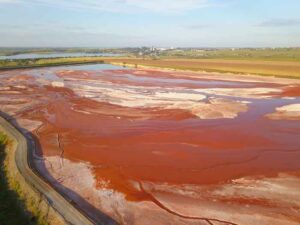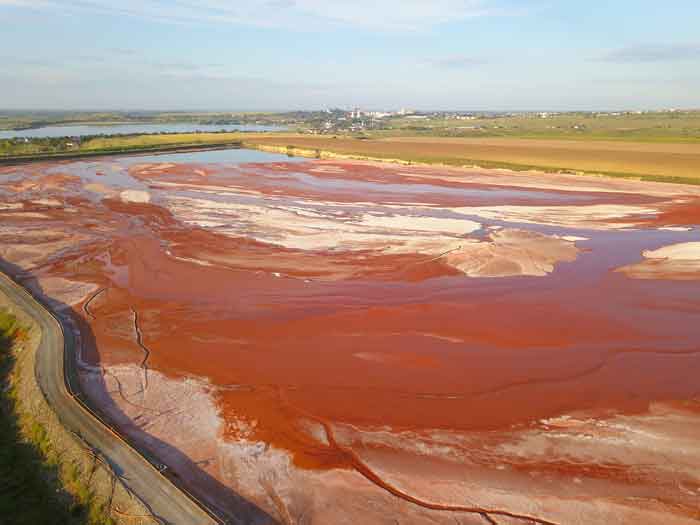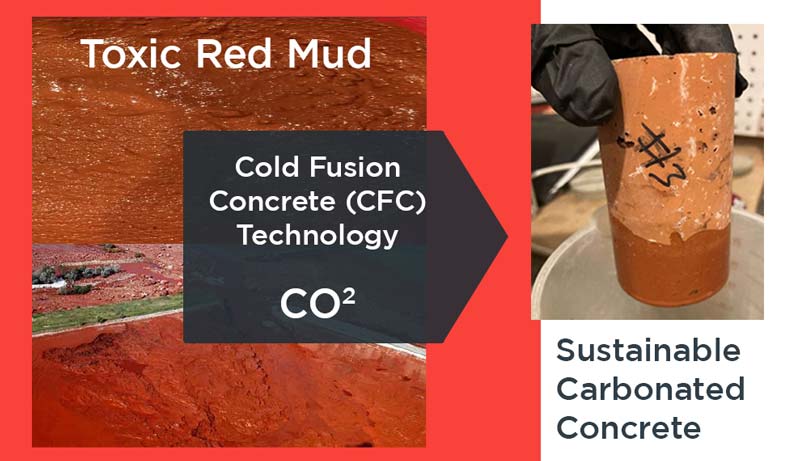
Transformer la boue rouge en béton durable
Découvrez comment la boue rouge toxique devient une ressource pour créer un béton durable, également connu sous le nom de béton de boue rouge, béton rouge ou béton géopolymère. Ces termes désignent le même matériau innovant créé par la réutilisation des déchets de boue rouge en un béton durable et respectueux de l'environnement.
Table des matières
- Qu'est-ce que la boue rouge ?
- La boue rouge est-elle toxique ?
- Impact environnemental et gestion des déchets
- Sites Superfund et efforts de nettoyage
- Production d'alumine et déchets industriels
- Création de béton à partir de boue rouge
- Séquestration du carbone dans la production de béton géopolymère
- Processus de production du béton de boue rouge
- Conclusion

Qu'est-ce que la boue rouge ?
Le processus industriel de production d'alumine génère un sous-produit important issu du traitement de la bauxite, connu sous le nom de boue rouge. Ce déchet pose des problèmes environnementaux majeurs en raison de son contenu dangereux et des vastes quantités produites. Cependant, des approches innovantes permettent de transformer cette substance toxique en béton géopolymère pour la construction durable. Cet article explore les avantages environnementaux et les processus impliqués dans l'utilisation des déchets industriels pour la construction durable.
La boue rouge est-elle toxique ?
Oui, la boue rouge est considérée comme toxique en raison de sa forte alcalinité et de la présence de substances dangereuses telles que l'hydroxyde de sodium et, dans certains cas, de traces de matières radioactives. Sa toxicité peut présenter de graves risques pour la santé humaine et l'environnement, surtout si elle n'est pas gérée correctement. La réutilisation de ces déchets industriels permet d'atténuer leur impact sur l'environnement.
Impact environnemental et gestion des déchets
L'utilisation de déchets industriels tels que les boues rouges est essentielle pour renforcer la résilience environnementale. Traditionnellement, nous les stockons dans de grandes retenues d'eau, ce qui entraîne une dégradation des sols et des risques importants.
Les pratiques actuelles de gestion des déchets sont souvent axées sur le respect des exigences légales plutôt que sur une gestion proactive de l'environnement. En transformant ce sous-produit en béton géopolymère, nous réduisons considérablement l'empreinte environnementale de la production d'alumine et contribuons à l'économie circulaire. Cette méthode utilise 100% de déchets de boue rouge et offre une alternative durable - et plus solide - aux matériaux de construction traditionnels.
Sites Superfund et efforts de nettoyage
Les Le programme Superfund de l'EPA s'occupe de certains des sites les plus pollués des États-Unis, notamment de nombreuses mines métalliques. Ces sites doivent souvent être recouverts et confinés afin d'éviter que les déchets industriels ne continuent à se dégrader, ce qui entraîne une perte permanente de terres. Les efforts de nettoyage sont coûteux et prennent du temps, et sont souvent financés par l'argent des contribuables.
En transformant ces déchets en une ressource précieuse, nous pouvons alléger le fardeau des sites Superfund. Cette approche innovante prévient les dégradations futures et réduit la nécessité d'opérations de nettoyage de grande envergure. En outre, elle favorise la réutilisation des terres polluées, transformant ainsi un passif en un atout pour les communautés.
Production d'alumine et boue rouge
La production d'alumine génère d'importants déchets, connus sous le nom de boues rouges, qui contiennent des produits chimiques nocifs et parfois des matières radioactives. La toxicité de ce sous-produit pose des risques à long terme, mais son utilisation dans la production de béton de boue géopolymère constitue une alternative sûre et durable pour les processus industriels.
Les industries produisent environ 130 millions de tonnes d'alumine par an, ce qui génère environ 240 millions de tonnes de déchets industriels. Ces déchets sont généralement stockés dans de grandes retenues d'eau, qui peuvent libérer des substances chimiques nocives dans l'environnement.
En utilisant ces déchets toxiques pour fabriquer du béton géopolymère, nous réduisons considérablement l'impact environnemental de la production d'alumine. Ce changement contribue à créer un processus industriel plus sûr et plus durable.
Création d'un béton de boue rouge
De nouvelles technologies permettent de recycler les boues rouges en béton géopolymère, conçu pour la construction et la réparation industrielles.
Cette méthode utilise des matériaux secs tels que le métasilicate de sodium pour former un béton durable et peu perméable qui incorpore les propriétés bénéfiques de la boue rouge. Ce processus permet non seulement de détourner les déchets des décharges, mais aussi de créer un matériau de construction très performant.
Le béton géopolymère offre une excellente résistance chimique et une durabilité supérieure à celle du ciment portland traditionnel.
L'intégration de déchets industriels dans la production de béton transforme l'industrie de la construction en offrant une alternative durable qui répond à des normes de performance rigoureuses.
Séquestration du carbone dans la production de béton géopolymère
Béton de fusion à froid facilite également la séquestration du dioxyde de carbone, ce qui réduit les émissions de carbone. En transformant les oxydes des déchets industriels en carbonates, le processus améliore la durabilité du béton et ses avantages environnementaux, ce qui en fait un matériau de construction durable.
La séquestration du carbone dans le béton géopolymère contribue à atténuer le changement climatique en capturant et en stockant le CO2, un important gaz à effet de serre. Cette nouvelle méthode réduit l'empreinte carbone de la fabrication du béton. Elle contribue également aux efforts mondiaux de lutte contre le changement climatique. L'utilisation de la boue rouge pour le piégeage du carbone montre comment les déchets peuvent contribuer à résoudre d'importants problèmes environnementaux.

Processus de production du béton de boue rouge
Le processus de production du béton de boue rouge comprend plusieurs étapes afin de garantir la qualité du produit final :
- Test : Tout d'abord, nous testons les propriétés chimiques de la boue rouge, essentielles pour garantir la sécurité et la durabilité du produit en béton final.
- Séchage et broyage : Après avoir été testée, la boue rouge est déshydratée et réduite en poudre fine, ce qui lui permet de se mélanger efficacement à d'autres matériaux.
- Mélange avec des additifs : Ensuite, nous mélangeons la poudre de boue rouge avec des activateurs et des matériaux pouzzolaniques pour créer un mélange de béton de boue rouge spécialisé qui offre résistance et durabilité.
- Transport du mélange : Enfin, nous transportons le mélange sec sur les chantiers de construction et le combinons avec de l'eau pour créer le béton géopolymère.
Ce processus de production tire parti de l'infrastructure existante, faisant du béton de boue rouge une solution économiquement viable et respectueuse de l'environnement.
Conclusion
La transformation de la boue rouge toxique en béton de boue rouge durable constitue une avancée importante dans la réduction des déchets industriels.
En transformant la boue rouge en une ressource précieuse, nous pouvons réduire l'impact sur l'environnement, améliorer la gestion des déchets et soutenir les pratiques de construction durable.
La poursuite de l'exploration des applications des boues rouges dans le béton géopolymère contribue à construire un avenir résilient et respectueux de l'environnement. L'adoption de ces technologies sera non seulement bénéfique pour l'environnement, mais elle renforcera également la résilience et la durabilité de notre environnement bâti.
Vous souhaitez en savoir plus sur la manière de transformer les déchets industriels en une ressource précieuse ? Contactez nousou explorer ressources supplémentaires sur la construction durable.

 [Étude de cas] Redéfinir l'ignifugation appliquée par pulvérisation avec Cold Fusion Concrete®.
[Étude de cas] Redéfinir l'ignifugation appliquée par pulvérisation avec Cold Fusion Concrete®.